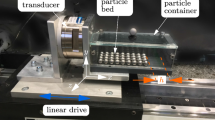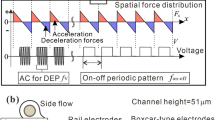Abstract
In this paper, steering a set of charged particles suspended in fluid flow within a plane channel is considered. In this way, the linear-state feedback control methodology is used to determine the external electric field. In order to design the proposed controller, at first, the governing mathematical ordinary differential equations are derived by the combination of Newton’s second law, Coulomb’s law and Navier–Stokes equations. Then, a linear quadratic regulator, which is one of the optimal control methods, is used to design the state-feedback control gains. For this purpose, continuous-time and discrete-time control methods are utilized. Simulation studies demonstrate the efficiency of the implemented control strategy for controlling the particles position and also tracking desired trajectories within the fluid flow. These results can contribute substantially to the development of related industrial processes.






Similar content being viewed by others
Abbreviations
- \({\bar{u}}_b\) :
-
Average velocity, \(\text {m s}^{-1}\)
- \(\forall \) :
-
Particles volume, \(\text {m}^{3}\)
- \(\kappa \) :
-
Dielectric constant
- \({\textbf{E}}_\textrm{c}\) :
-
Electric field (control input), \(\text {V m}^{-1}\)
- \({\textbf{g}}\) :
-
Gravitational acceleration, \(\text {m s}^{-2}\)
- \({\textbf{r}}_{ij}\) :
-
Distance between particles i and j, m
- \({\textbf{V}}\) :
-
Fluid velocity vector, \(\text {m s}^{-1}\)
- \({\textbf{X}}\) :
-
State vector
- h :
-
Channel width, m
- \({{\textbf{F}}_\textrm{E}}\) :
-
Electric field force vector, N
- \({{\textbf{F}}_\textrm{W}}\) :
-
Weight force vector, N
- \({{\textbf{P}}}\) :
-
Pressure vector, Pa
- \({\varepsilon _0}\) :
-
Permittivity of free space
- \({d_\textrm{P}}\) :
-
Particles diameter, m
- \({E_\textrm{ex}}\) :
-
External electric field, \(\text {V m}^{-1}\)
- k :
-
Coulomb’s constant
- m :
-
Particles mass, kg
- q :
-
Electric bar, C
- u :
-
Fluid velocity in x direction, \(\text {m s}^{-1}\)
- v :
-
Fluid velocity in y direction, \(\text {m s}^{-1}\)
- x :
-
Streamwise direction
- y :
-
Spanwise direction
- \({{\textbf{F}}_\textrm{B}}\) :
-
Buoyancy force vector, N
- \({{\textbf{F}}_\textrm{C}}\) :
-
Coulomb force vector, N
- \({{\textbf{F}}_\textrm{D}}\) :
-
Drag force vector, N
- \({{{\textbf{V}}_\textrm{p}}}\) :
-
Particles velocity vector, \(\text {m s}^{-1}\)
- \({{{\textbf{x}}_\textrm{P}}}\) :
-
Particles position vector, m
- \({{\mu _\textrm{f}}}\) :
-
Fluid dynamic viscosity, \(\text {kg m}^{-1}~\text {s}^{-1}\)
- \({{\rho _\textrm{f}}}\) :
-
Fluid density, \(\text {kg m}^{-3}\)
- \({{\rho _\textrm{p}}}\) :
-
Particles density, \(\text {kg m}^{-3}\)
References
Sun T, Zhang YS, Pang B, Hyun DC, Yang M, Xia Y (2014) Engineered nanoparticles for drug delivery in cancer therapy. Angew Chem Int Ed 53(46):12320–12364
Nacev A, Komaee A, Sarwar A, Probst R, Kim SH, Emmert-Buck M, Shapiro B (2012) Towards control of magnetic fluids in patients: directing therapeutic nanoparticles to disease locations. IEEE Control Syst Mag 32(3):32–74
Wei W, Gu Z (2015) Electrification of particulate entrained fluid flows—mechanisms, applications, and numerical methodology. Phys Rep 600:1–53. Electrification of particulate entrained fluid flows—Mechanisms, applications, and numerical methodology
Saiyasitpanich P, Keener TC, Khang S-J, Lu M (2007) Removal of diesel particulate matter (DPM) in a tubular wet electrostatic precipitator. J Electrostat 65(10):618–624
Law SE, Giles DK (2009) Electrostatic abatement of airborne respirable dust emission from mechanized tree-nut harvesting: theoretical basis. J Electrost 67(2):84–88. 11th international conference on electrostatics
Komaee A, Shapiro B (2011) Magnetic steering of a distributed ferrofluid spot towards a deep target with minimal spreading. In: 2011 50th IEEE conference on decision and control and European control conference, pp 7950–7955
Komaee A, Shapiro B (2012) Steering a ferromagnetic particle by optimal magnetic feedback control. IEEE Trans Control Syst Technol 20:1011–1024
Amiahmadi H, Beigzadeh BA (2017) Numerical simulation of micro/nano magnetic particles movement in bloodstream considering interaction of particles. Modares Mech Eng 17(4):307–314
Komaee A (2017) Feedback control for transportation of magnetic fluids with minimal dispersion: a first step toward targeted magnetic drug delivery. IEEE Trans Control Syst Technol 25(1):129–144
Yu K, Yi J, Shan J (2018) Simultaneous multiple-nanowire motion control, planning, and manipulation under electric fields in fluid suspension. IEEE Trans Autom Sci Eng 15(1):80–91
Yu K, Yi J, Shan JW (2018) Real-time motion planning of multiple nanowires in fluid suspension under electric-field actuation. Int J Intell Robot Appl 2:383–399
Ablay G, Böyük M, İçöz K (2019) Design, modeling, and control of a horizontal magnetic micromanipulator. Trans Inst Meas Control 41(11):3190–3198
Böyük M, Eroǧlu Y, Ablay G, İçöz K (2020) Feedback controller designs for an electromagnetic micromanipulator. Proc Inst Mech Eng I J Syst Control Eng 234(6):759–772
Watanabe T (1989) Calculation of fly ash particle motion and its migration velocity in an electrostatic precipitator. In: Conference record of the IEEE industry applications society annual meeting, vol 2, pp 2126–2136
Meroth AM, Rastogi AK, Schwab AJ (1996) Numerical computation of the turbulent particulate flow in an electrostatic precipitator. In: International symposium on filtration and separation of fine dust (Vienna), pp 994–1001
Cristina S, Feliziani M (1995) Calculation of ionized fields in DC electrostatic precipitators in the presence of dust and electric wind. IEEE Trans Ind Appl 31(6):1446–1451
Choi B, Fletcher C (1998) Turbulent particle dispersion in an electrostatic precipitator. Appl Math Model 22(12):1009–1021
Jung JH, Oh H, Kim SS (2010) Numerical simulation of the deposition pattern in multiple electrohydrodynamic spraying. Powder Technol 198(3):439–444
Liu Q, Song Zhang S, Pei Chen J (2015) Numerical analysis of charged particle collection in wire-plate ESP. J Electrost 74:56–65
Durst F, Miloievic D, Schönung B (1984) Eulerian and Lagrangian predictions of particulate two-phase flows: a numerical study. Appl Math Model 8(2):101–115
Rezvanpour A, Wang CH (2014) The effects of auxiliary electric field within the electrohydrodynamic atomization encapsulation chamber on particle size, morphology and collection efficiency. Chem Eng J 239:8-18
White HJ (1984) Control of particulates by electrostatic precipitation. Wiley, New York
Belanger PR (1995) Control engineering: a modern approach, 1st edn. Oxford University Press, Oxford
Neves GP, Angélico BA (2021) A discrete LQR applied to a self-balancing reaction wheel unicycle: modeling, construction and control. In: 2021 American control conference (ACC), pp 777–782
Franklin GF, Powell JD, Workman ML (2006) Digital control of dynamic systems, 3rd edn. Ellis-Kagle Press, Austin
Ogata K (1995) Discrete-time control systems, 2nd edn. Prentice-Hall, Hoboken
Hockney RW, Eastwood JW (1988) Computer simulation using particles. CRC Press, Boca Raton
Greengard L, Rokhlin V (1997) A fast algorithm for particle simulations. J Comput Phys 135:280–292
Essmann U, Perera L, Berkowitz ML, Darden T, Lee H, Pedersen LG (1995) A smooth particle mesh Ewald method. J Chem Phys 103(19):8577–8593
Funding
The authors did not receive support from any organization for the submitted work.
Author information
Authors and Affiliations
Contributions
This manuscript is prepared based on the M.Sc. thesis of E. Motamedi, B. Rahmani and A. Moosaie are his supervisors in this research.
Corresponding author
Ethics declarations
Conflict of interest
The authors declare that they have no known competing financial interests or personal relationships that could have appeared to influence the work reported in this paper.
Additional information
Publisher's Note
Springer Nature remains neutral with regard to jurisdictional claims in published maps and institutional affiliations.
Rights and permissions
Springer Nature or its licensor (e.g. a society or other partner) holds exclusive rights to this article under a publishing agreement with the author(s) or other rightsholder(s); author self-archiving of the accepted manuscript version of this article is solely governed by the terms of such publishing agreement and applicable law.
About this article
Cite this article
Motamedi, E., Rahmani, B. & Moosaie, A. Position control of charged spherical particles suspended in laminar flow within a channel. Comp. Part. Mech. 10, 853–864 (2023). https://doi.org/10.1007/s40571-022-00537-y
Received:
Revised:
Accepted:
Published:
Issue Date:
DOI: https://doi.org/10.1007/s40571-022-00537-y




